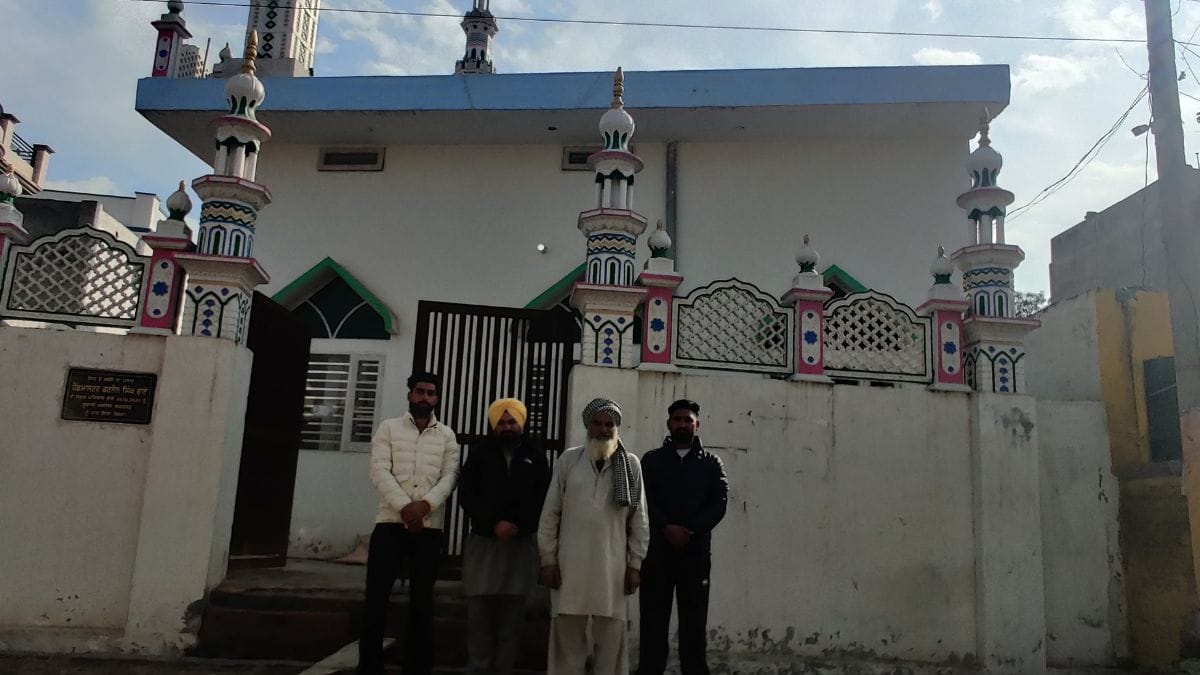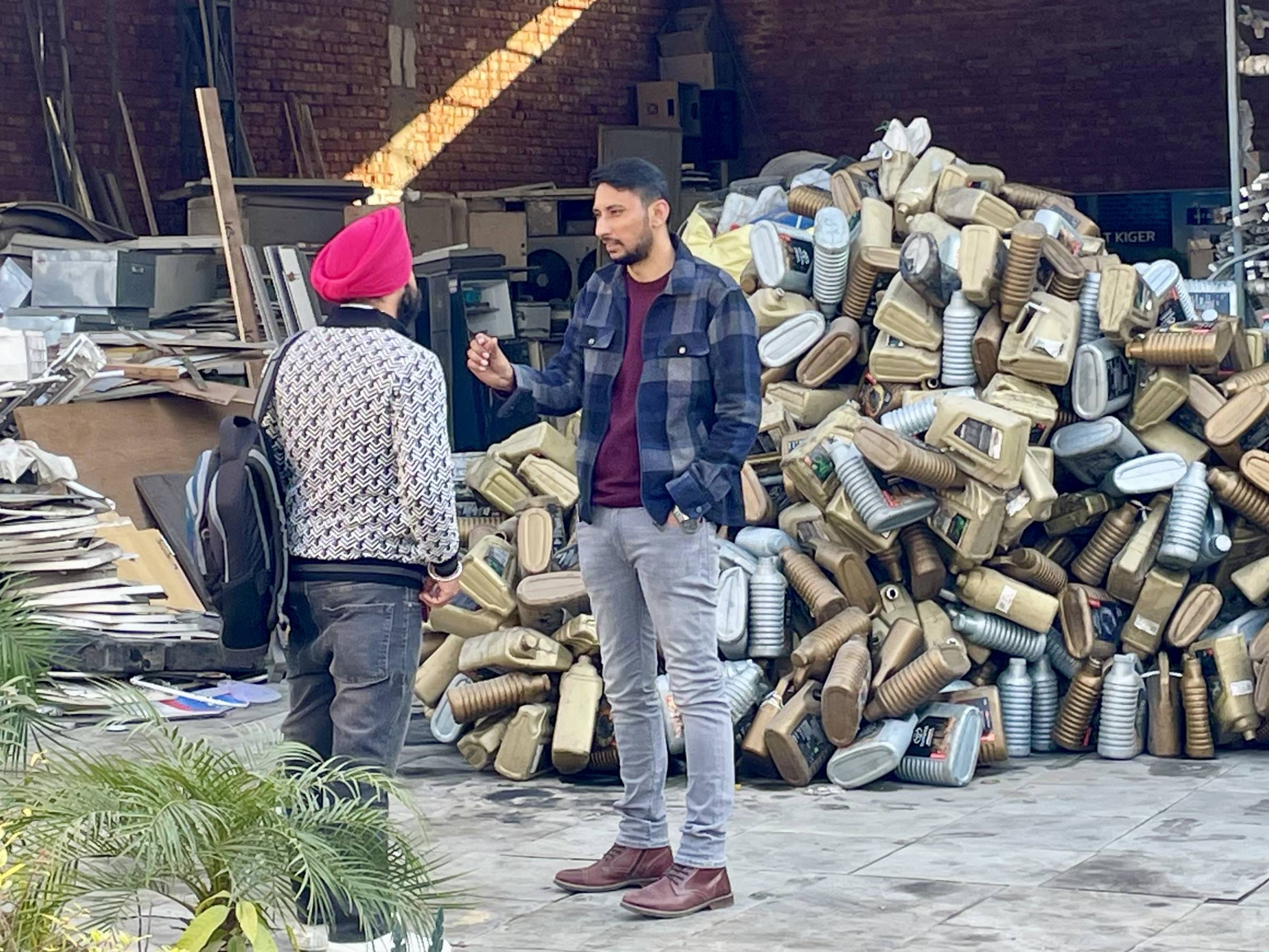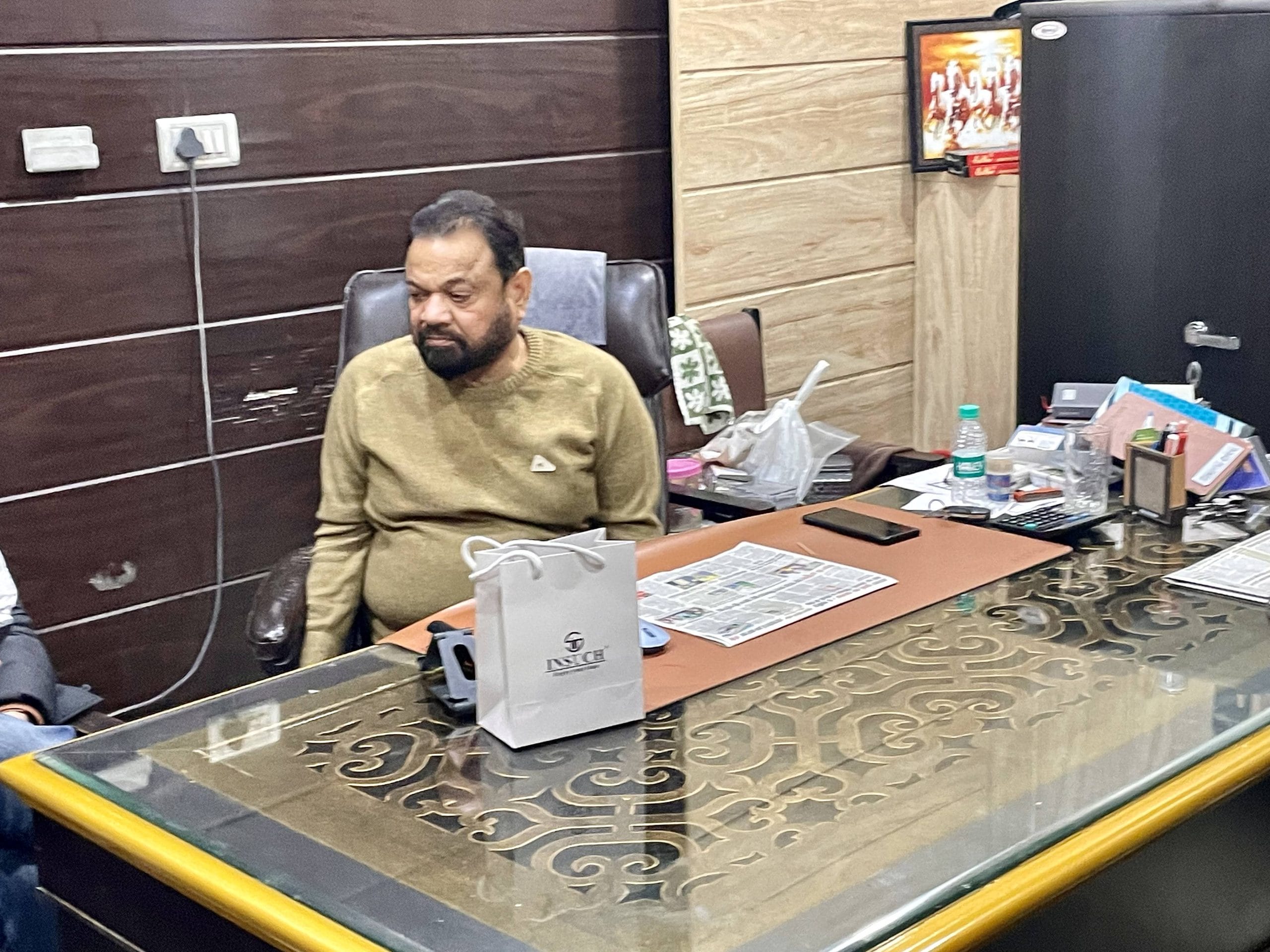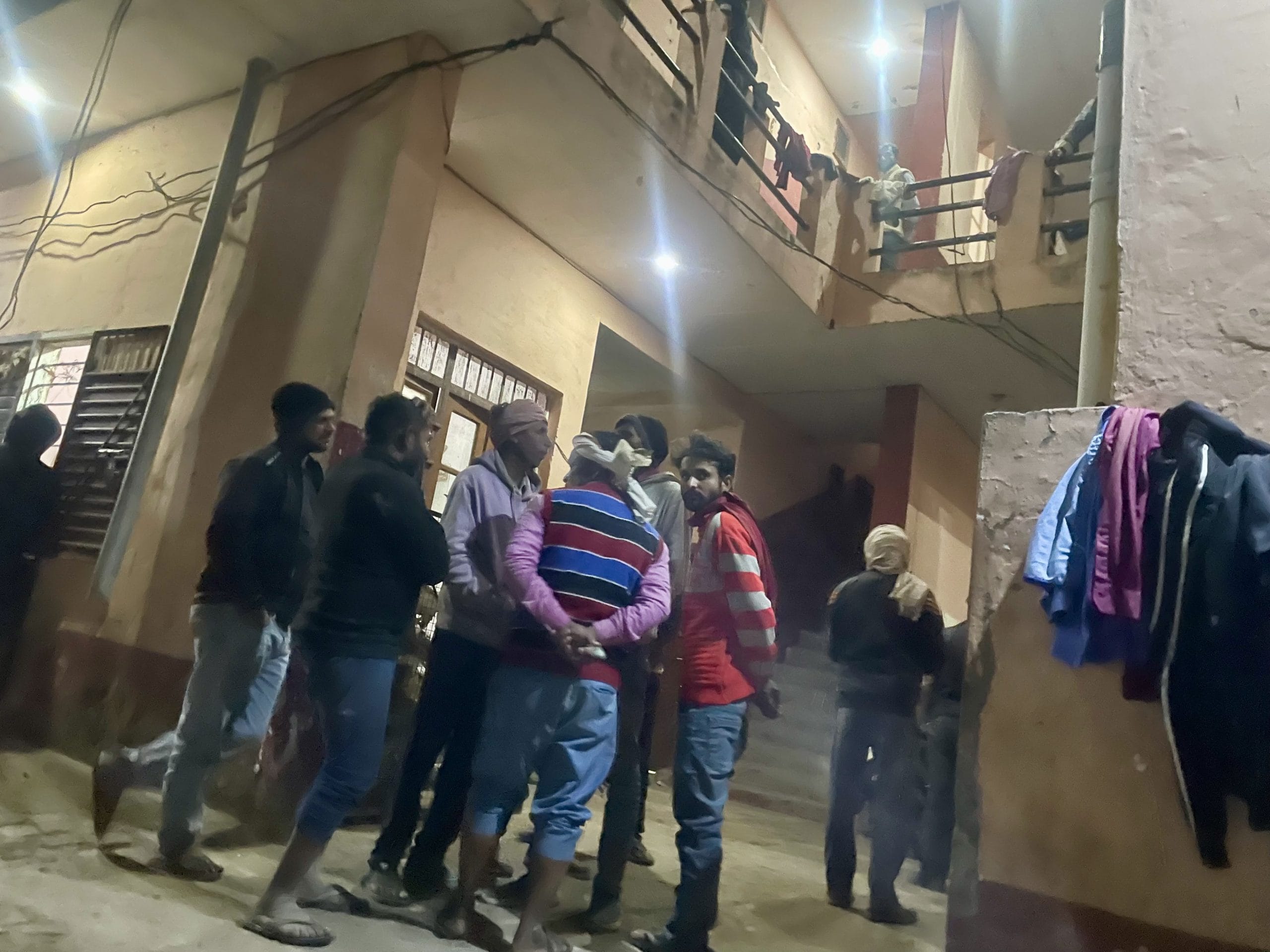Ludhiana: It took a small army of workers, one year, and over twelve lakh rupees to build Masjid Umar bin Khattab in Punjab’s Bakhatgarh village. With its blue and pink-lined white minarets, the gleaming new mosque is a spiritual sanctuary–not just for the 15-odd Muslim families in a village of 3,500, but also for the new Muslim migrant workforce from Uttar Pradesh and Bihar.
Punjab’s demographics are changing slowly. And so is its skyline.
It all began when a Sikh resident gifted eight ‘marlas’ of land to Bakhatgarh’s Muslims in 2022, recognising their need for a place of worship. Before this, Muslim residents had to travel four kilometres to another village just to pray in a mosque.
“The construction of this mosque was a collaborative effort by Muslims from the village, residents who belong to other religious communities, and Muslims from outside Punjab. While many Muslims work here only seasonally, it’s nice to finally have such a space,” said the local veterinary doctor, Moti Khan, while stepping out of the masjid.

According to Khan, Muslim Families from Uttar Pradesh and Uttarakhand donated approximately Rs 6 lakh toward the mosque’s construction.
But Bakhatgarh’s new mosque, built in 2023, isn’t just a one-off token nod to the village’s changing socio-religious landscape. From farmlands to the industrial suburbs of Ludhiana, there’s a concerted effort across Punjab to either revive pre-Partition mosques or build new ones. The Jamaat-e-Islami Hind’s state unit representative said on condition of anonymity that 165 such mosques have come up or been restored in the past five years. It’s a reflection of—and reaction to—the state’s shifting migration patterns.
India’s poster child for outbound migration, particularly through ‘dunki’ routes to Canada and America, Punjab is now embracing Muslims from Uttar Pradesh, Uttarakhand, Bihar and even West Bengal. And they are beginning to put down roots in the state.
Many farm labourers visit this mosque when they come to Punjab for four-five months each year. I myself am from Purnea in Bihar – Mohammad Nizamuddin, maulvi of Bakhatgarh mosque
Interstate seasonal migration has been on the rise since the 1990s. What’s different now is that workers are bringing their families with them too. This change in Punjab’s social fabric has ignited a debate over whether it’s being fuelled by an acute labour shortage in the state or by politics.
Meanwhile, more and more mosques are being built on the ground—with the help of the local Sikh community. A trend that runs in parallel with the increase in Muslim migrants to the state.
“Many farm labourers visit this mosque when they come to Punjab for four-five months each year. I myself am from Purnea in Bihar,” said the maulvi of Bakhatgarh’s mosque, Mohammad Nizamuddin.
There’s no official data on the socio-economic or religious background of the workers and businesses moving to Punjab. But the region is slowly and evidently witnessing the return of Muslims, who made up the largest chunk of its population before Partition.
Nobody comes for religious reasons, of course. But recent years have seen an increase in the migration of Muslims from UP due to the atmosphere there. They are coming here not just for work, but to permanently settle – Sarwar Ghulam Saba, president of the Punjab unit of the Islamic Welfare Society
This trend is not limited to rural Punjab for agricultural jobs. It’s unfolding in cities, industrial hubs, textile manufacturing units and factories in Ludhiana, Chandigarh, and Jalandhar.
“Several workers, along with self-employed individuals and small and middle-level businessmen, are settling here with their families, unlike earlier, when they would go back home. In the past five years, their population might have almost doubled,” said Mazhar Alam, the Jalandhar district president of Jamiat Ulema-e-Hind and president of Masjid Quba in Khambra.
UP to Punjab
In Sahnewal town on the outskirts of Ludhiana, Mohammad Ahad inspects piles of e-waste—desktop computers to laptops—spread across the sprawling yard at his factory. Though Ahad traces his roots to UP’s Saharanpur, he has lived in Ludhiana for over 25 years. It’s where he built his e-waste business. He stops to take a phone call from another Muslim entrepreneur, speaking in the drawling, sing-song Hindi accent characteristic of Western UP.
“What’s happening with the housing society coming up on Tajpur Road?” he asks his friend, who is from Varanasi and runs a furniture business. “Are they giving homes to Muslims easily?”

Many in Ahad’s network have moved to Punjab in recent times, or are planning to. He knows of at least five Muslim families from Varanasi—all in the furniture business—who are currently in the process of shifting to Ludhiana. “It’s not for business reasons alone; they are also shifting because they had altercations in their neighborhood. Something that has never happened before,” he said.
Ahad’s father, Mohammad Irfan (65), came to Punjab as a sugar mills contractor in the early 2000s. Today, all three of his children are settled here; Ahad is even married to a woman from a Ludhiana-based migrant family.
It’s better to get the children educated in a place like Ludhiana. There’s nothing in Saharanpur – Mohammad Ahad, Ludhiana factory owner
According to Irfan, “At least 10 other families” from western UP, who came to Punjab around the same time as him, have settled in their Tajpur Road neighbourhood.
Dilshad (29), a worker at the e-waste plant, also left his hometown of Nanauta in Saharanpur about a decade ago.
His wife and children are still back home in UP, but he plans to bring them to Ludhiana soon.
“It’s better to get the children educated in a place like Ludhiana. There’s nothing in Saharanpur,” he said. Versions of the same story—the relocation and rebuilding of lives—reveal themselves in the surrounding neighbourhoods of Ludhiana—Jugiana, Ram Nagar, and Tajpur Road, among others.
According to the 2011 Census, Uttar Pradesh, Haryana and Bihar have sent the largest percentages of migrants to Punjab. The state is home to over 6,50,000 and 3,50,000 migrants from UP and Bihar, respectively. A reply to a 2023 question in the Rajya Sabha revealed that the state had nearly 12,44,056 migrant workers as of 2011, with another 2,06,642 workers based in Chandigarh alone.
Data from the 2011 census also reveals that Punjab was home to nearly 2,52,688 Muslims in 1971, which rose to 5,35,489.
Since 1947, Malerkotla and Qadian–the latter being the centre of the Ahmadiyya sect–have been the only places synonymous with Muslims in Punjab. The Muslim population in Malerkotla increased from 15.2 per cent in 1971 to 22.5 per cent in 2011. Much has been said about Malerkotla’s exceptionalism. But the number of Muslims in Punjab outside of Malerkotla and its home district Sangrur, has risen from 53,000 to over 3,56,000 from 1971 to 2011.
Ludhiana has a 45,473 strong Muslim community as of the 2011 Census. Its hosiery, textiles and steel manufacturing industry attracts labour from all across India.
“Nobody comes for religious reasons, of course. But recent years have seen an increase in the migration of Muslims from UP due to the atmosphere there. They are coming here not just for work, but to permanently settle,” said Sarwar Ghulam Saba, president of the Punjab unit of the Islamic Welfare Society.
The uptick in the restoration of old mosques and the building of new ones is a response to this rising demand, she added.
Also read:
Building & restoring mosques
Back in Bakhatgarh village, Amandeep Singh often stops on his way home to look at the gleaming mosque, and beams with pride. It was his donation of land that set the ball rolling for the mosque.
“I have just one son who has settled in Canada. So my family is pretty small, and I didn’t need that land. I thought it was a good deed to donate it, for the sake of upholding a sense of community,” he said.
Bakhatgarh residents came together and raised about Rs 2 lakh for the project. Muslim donors and charitable trusts, among other sources, fulfilled the deficit with their contributions. People from neighbouring villages provided further assistance in the form of construction materials such as cement and bricks. The maulvi, Mohammad Nizamuddin, hinted
that at least four such mosques are currently being built in nearby areas.
In Bhotna, just two kilometres from Bakhatgarh, work is on to reconstruct a pre-1947 mosque.
“Recently, we saw a video on WhatsApp showing the revival of a masjid in Umarpura as well. It’s good to finally have some space,” said Bhola Khan, a resident of Bakhatgarh now in his 50s, whose family has been in Punjab since before Partition.
In Barnala district’s Moom village, residents—Hindus, Sikhs and Muslims—contributed Rs 12 lakh to construct ‘Aman Masjid’ in 2020. More recently, in March 2023, another village, Kutba Bahmania, also in Barnala district, saw the reconstruction of its first mosque after the original structure fell into disrepair post 1947.

In 2021, village head Pala Singh spearheaded an initiative to restore a pre-Partition mosque in Bhalloor.
“After Partition, most Muslim families left for Pakistan and the mosque went into ruins. The new mosque will be built on the same land,” Singh had told the media back then.
The emergence of mosques is also accompanied by videos painting a picture of communal amity in rural Punjab.
As recently as January this year, photos and videos emerged on social media, publicising the inauguration of a new mosque in Malerkotla’s Umarpura village after former sarpanch Sukhjinder Singh Noni and his brother decided to give away their land for the construction of a mosque. Punjab’s Shahi Imam, Mohammad Usman Rehman Ludhianvi, laid the first bricks for the Umarpura mosque on 12 January.
But Ludhianvi insisted that the building and restoration of mosques was “not a new phenomenon”.
“There is a misconception that the only Muslims in Punjab are from Malerkotla. The community exists across the state, especially in rural Punjab. I do not buy the narrative that this (building of mosques) is in response to migration patterns, because if you go to rural Punjab, mosques already exist, ” he said.
People are only talking about it now, he added, because of “social media and the prevailing political landscape”.
“These videos have caught the public’s attention thanks to the way they show Punjabi culture with a mutual respect for all religions,” the Shahi Imam said. But soon after this declaration, he claimed that close to 50 such mosques have been built across villages in the past two or three years.
Also read:
More business, security?
In Ludhiana, businessman Alimuddin Saifi greeted a group of Punjabi friends who walked into his office in his banquet-style hotel, holding a box of mithai.
“The family that just came to invite me to their wedding, they are Punjabi Hindus. I’m not saying there’s more brotherhood here, but I feel I’ve built a stronger community here,” he said. “People are not going around issuing threats to shut down Muslim-owned businesses. Nobody is asking me to put a signboard outside my hotels or factories to state my name or religious identity.”

A portly man in his 50s, Saifi hails from Muzaffarnagar. His family is involved in the garment business, and has been operating from Ludhiana and Jalandhar since the 1960s. However, it is only now that he is certain that future generations of his UP-origin family will settle in Punjab permanently.
“When the Khalistan movement happened in the 1980s, you’d hear anecdotes of families, especially from rural areas, telling their sons to leave Punjab. It’s the same for us Muslims in Uttar Pradesh now. Wherever there is more crackdown, there’s a stronger urge to leave,” said the businessman, who owns a woollen and winter garments company along with a hotel in Ludhiana.
When his father first arrived in Punjab in the 1960s and expanded his hosiery business, the rest of his family remained in UP. Saifi only migrated to Ludhiana in the 1980s. Now, he and his brothers are part of the community, settled in the area for good.
Saifi emphasised how no Muslim he knows in Ludhiana would openly admit to shifting for political reasons. “But when you live in a state where there is a likelihood of your home being bulldozed, who wants to go back and run a business there?”
He scrolled through video clips on his WhatsApp family group and shared one that showed policemen outside the house of Sambhal legislator Zia-ur-Rehman Barq, investigating his residence for evidence of ‘electricity theft’. The incident occurred in December 2024. Notably, Barq was among those booked in connection with the November 2024 clashes in Sambhal, which had resulted in the deaths of residents and security personnel.
The group had been sharing videos of the violence at Sambhal, referring to the dehshat (fear) in the region. But there are rumblings of discontent in Punjab as well. Saifi often has hushed discussions with e-waste plant owner Mohammad Ahad, about gangster-turned-politician Lakha Sidhana and his anti-migrant rhetoric. In an Instagram reel, Sidhana can be heard saying that Punjab’s villagers ought to ensure that UP and Bihar’s migrant workers don’t get enrolled as voters or shift their permanent residences here.
Meanwhile, nearly 100 kilometres away, in the Chandigarh tricity area, some like Tabrez Alam are sceptical of such anecdotal accounts. A 50-year-old real estate dealer and businessman from Sambhal, Alam has been living and working on the outskirts of Chandigarh, near Mohali’s Kharar region. He insisted that the migrant movement is driven solely by economic prospects. Waving his bejewelled hands in the air, he waxes eloquent about Islam and Sikhism’s “spiritual similarities”, and his own love for “Punjab’s spiritual culture”. He pointed to the construction of “a couple of masjids in the Kharar area” as a sign of a greater migrant population, including more Muslims.
“But more masjids aren’t being built because of Muslim migration; Migration is religion-agnostic. If one Muslim family is leaving, then so are four Hindu families. My brother and I moved here because we share a strong bond with Punjab,” Alam said, adding that there’s a sense of safety in the fact that “Sikhs (as a community) tend to support Muslims.”
Alam and his family have lived in Chandigarh for close to two decades. His children, who are now done with school, are expressing a desire to move abroad in the future – just like their Punjabi counterparts.
Also read: 2020 riots changing Delhi. Muslims, Hindus leaving old neighbourhoods, moving to ghettos
Residents vs ‘bhaiyyas’
For all the talk of safety and security, there’s an undercurrent of tension amid piecemeal narratives of politically motivated flight. Hostility and xenophobia are erupting with increasing regularity.
In December 2024, the panchayat of Jawaharke village in Mansa district passed a resolution prohibiting villagers from marrying “outsiders” (migrants) and banning intra-village marriages. The rules came into effect on 30 November last year, when a copy of the signed resolution was made public. The resolution stated that those violating the order would face expulsion from the village.
Naujawan Sabha, a Sikh youth outfit operating in the Jandpur village near Chandigarh, has also amped up its anti-outsider campaign.

In August 2024, the group issued a set of rules prohibiting migrants from going into the village after dark and loitering around in underwear. These restrictions were listed on boards across the village, including gurdwaras, with messages threatening legal action against migrants for spitting in public places, selling drugs, and allowing underage driving.
At a bustling hostel-style accommodation in one such migrant worker pocket of Jandpur, a crowd of young men from Bihar’s Bettiah district loiter around a paan and grocery shop. Pramod Paswan (35) sighs as he opens his phone to scroll to a photo of Lakha Sidana.

“This man, Lakha Sidana, has become famous for his xenophobic rhetoric…There are no jobs back home, so we come here for work. Our labour here is seasonal, sab mistri ka kaam karte hai (we all work as masons). We live in hostels divided by district. Some people from Darbhanga live nearby,” said Paswan.
His job as a daily-wage mason fetches him between Rs 12 to 14,000 per month. But the fracas created by anti-migrant groups has left him scarred. Another labourer from Bettiah said that residents are wary of their hostel, which houses some 800 migrant workers.
A middle-aged Sikh woman who lives right next to the hostel is unhappy with the men gathering around it every evening and night.
“Men keep loitering outside at night. If someone doesn’t feel safe, I think it’s justified to have restrictions. Too many migrants have been coming here in the past few years, they’re taking over our area and now even settling with their families,” said the woman, who does not wish to be named.
The sentiments have now found their way into political rhetoric. During the Lok Sabha polls in Punjab, Congress leader Sukhpal Khaira said that migrant labourers, mostly from UP and Bihar, should not have the right to buy land and settle in Punjab.
Before this, Khaira, along with Leader of the Opposition Partap Singh Bajwa, had sought to introduce a private member’s bill in the Punjab assembly to impose restrictions on the purchase of agricultural land by non-Punjabis. This was, as Khaira put it, “to protect our identity and demographic balance” along the lines of the Himachal Pradesh Tenancy and Land Reforms Act 1972.
Migrant labourers, both Muslims and Hindus, say that this is just rhetoric.
“Locals are not willing to do this work, their sons are off to Canada. We are the ‘bhaiyyas’, but we’re doing the work they refuse to do,” Paswan said, referring to the discriminatory moniker used for poor migrant workers from UP and Bihar.
But for businessmen like Ahad, Punjab is home for good.
“Sikhs here support Muslims. It’s relatively better,” he said. He brushed aside incidents of gatekeeping that are now slowly cropping up.
“The developers told me that they won’t sell to Muslims,” said Ahad, referring to the upcoming housing society in Tajpur he was discussing with his friend earlier. “But that aside, go to the industrial and commerce hubs, there are plenty of migrants living there. This includes Muslim families.”
(Edited by Zoya Bhatti)







The underlying thought coming across this article is that Muslims are shifting because they are feeling unsafe in their respective states…thats a mischievous article against the Hindu community at large. People and at times communities have done so for economic prospects.
Very clever very intelligent continuity enhancing action …..bharat can sleep or watch lazily it is swasthaanavardhaka move ?
As society gradually changes, it can sometimes lead to social unrest over time. In Kerala, we’ve seen some of this happen due to the influence of vote bank politics.
Punjab is a very sensitive border state with a gruesome and painful history of secessionist violence. Thousands had died in the two decade long insurgency.
In this scenario, any such demographic shift can lead to rekindling of religious and ultimately secessionist violence. Pakistani agencies would only be too glad to use the opportunity to further their cause.
Punjab government and Indian security agencies must wake up to this grave danger to national security.